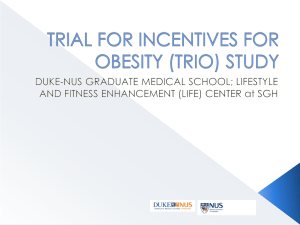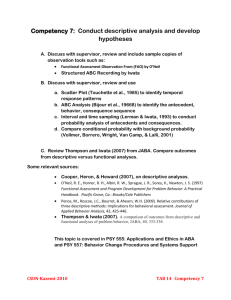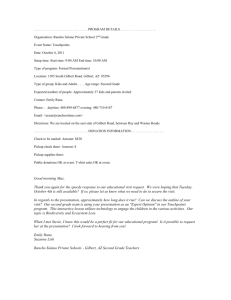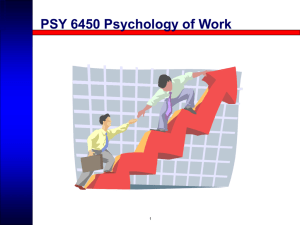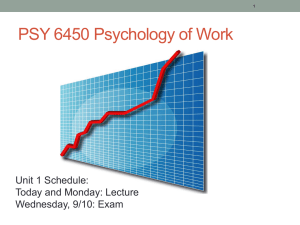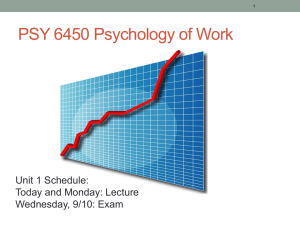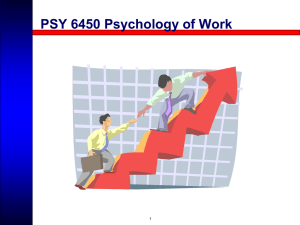Unit 2: Performance Assessment & Measurement
advertisement
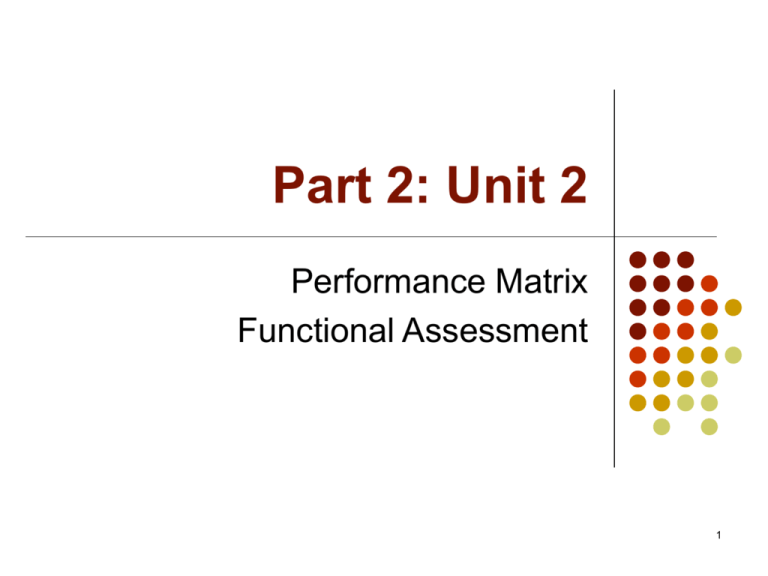
Part 2: Unit 2 Performance Matrix Functional Assessment 1 Skip to SO16 Performance Matrix Only SO13 is for the exam I am not going to cover that in lecture - unless someone has a question about it But remember anything I skip in lecture is still fair game for the exam as long as there is a study objective on it! 2 3 SO16: Performance Matrix Daniels1 Generated from Felix & Riggs Abernathy Balanced Scorecard Created as a measurement tool Performance Scorecard Unique feature: performance indexing (weighting/prioritizing) 1 Performance Matrix power point slides: © 2006 AUBREY DANIELS INTERNATIONAL, INC. FOR USE EXCLUSIVELY BY EDUCATORS IN ACADEMIC INSTITUTIONS. 4 Why 4-12 for columns, with 5=baseline and 10=goal? Sample Matrix Behaviors or Results 4 5 Below Baseline Above goal 6 Raw Score 7 8 9 10 11 12 Points 100 Sub-goals Baseline (not current) Performance Weight Total Pts. Goal © 2006 AUBREY DANIELS INTERNATIONAL, INC. FOR USE EXCLUSIVELY BY EDUCATORS IN ACADEMIC INSTITUTIONS. 5 Sample Matrix: Postal Worker Behaviors or Results 4 5 6 7 8 9 10 11 12 Weight Appropriate Greeting Number of Bins Sorted 59% 60% 65% 70% 75% 80% 85% 90% 98% Till Correct 91% 92% 93% 96% Number of Complaints1 3 6 4 5 5 6 4 7 8 9 Raw Score Points 10 12 97% 98% 99%100% 3 2 1 0 100 Sub-goals Baseline Performance 1Note: Total Pts. Goal number of complaints, less is better 6 Sample Matrix Distribution=100 Behaviors or Results 4 5 6 7 8 9 10 11 12 Weight Appropriate Greeting Number of Bins Sorted 59% 60% 65% 70% 75% 80% 85% 90% 98% Till Correct 91% 92% 93% 96% Number of Complaints 3 6 4 5 5 4 6 7 8 9 10 12 97% 98% 99%100% 3 2 1 0 Raw Score Points 35 25 30 10 100 Sub-goals Baseline Performance Total Pts. Goal © 2006 AUBREY DANIELS INTERNATIONAL, INC. FOR USE EXCLUSIVELY BY EDUCATORS IN ACADEMIC INSTITUTIONS. 7 Sample Matrix: What would the points be? Actual performance/Data Behaviors or Results 4 5 6 7 8 9 10 11 12 Weight Appropriate Greeting Number of Bins Sorted 59% 60% 65% 70% 75% 80% 85% 90% 98% Till Correct 91% 92% 93% 96% Number of Complaints 3 6 4 5 5 4 6 7 8 9 10 12 97% 98% 99%100% 3 2 1 0 Raw Score 35 70% 25 9 30 95% 10 1 Points 100 What would Sub-goals Baseline Performance Total Pts. Goal © 2006 AUBREY DANIELS INTERNATIONAL, INC. FOR USE EXCLUSIVELY BY EDUCATORS IN ACADEMIC INSTITUTIONS. 8 Link to rewards: Use points to determine level of reward Points Reward 700-799 Borders Café gift card, Blockbuster rental 800-899 extra 1/2 hour for lunch 900-999 gift certificate for favorite store or restaurant 1000-1200 1/2 day off on Friday *Group contingency: If everyone reaches 750, the whole office goes to lunch on the boss © 2006 AUBREY DANIELS INTERNATIONAL, INC. FOR USE EXCLUSIVELY BY EDUCATORS IN ACADEMIC INSTITUTIONS. 9 Skipping to SOs 18&19: Lecture study objectives, intro The Pampino et al. article used a functional assessment (the Performance Diagnostic Checklist by Austin) to determine what interventions were needed Functional assessments have received more attention lately, although most practitioners and, many researchers have used some type of assessment to determine what their interventions should be The term “functional assessment” comes from Iwata’s work in DD and autism - determination of what is controlling self-injurious behavior 10 Functional Assessment, intro In OBM, the term has become more transparent due to Austin’s PDC and Wilder’s recent publications, but these type of analyses have existed for many years in both OBM and I/O - just not called “functional assessment” An “ABC” analysis is a functional assessment Mager & Pipe, 1970, flowchart to determine whether a performance problem was a training problem or a consequence problem Petrock, 1978, balance of consequences Brown, 1982, included balance of consequences in his book Daniels & Rosen, 1982, modified it into “PIC/NIC” These all focused on the consequences of behavior, without expanding the analysis to management and organizational level systems analysis Brethower was the first to do that in his 1972 systems analysis book with his Total Performance System diagram and concept - but it “didn’t catch on 11 SO18: Three types of functional assessment Informant Descriptive Direct observation of the employees: generally considered to be more reliable than informant Functional analysis Interviews, questionnaires, rating scales or some other “indirect” (verbal) method: a bit suspect as are all verbal reports Experimental analysis - the systematic manipulation of specific antecedents and consequences that may affect the target behavior: most reliable, but often difficult in organizational settings Good example, Pampino, Wilder, & Binder (2005) to determine why foremen were entering wrong job codes In OBM, most common is to combine informant and descriptive 12 SO19: Three popular functional assessment procedures in OBM Gilbert’s Behavioral Engineering Model, 1978 Binder’s Six Boxes (very nice ABA presentation, 2006) Directly derived from Gilbert, but copyrighted Austin’s Performance Diagnostic Checklist Earliest one that “caught on” and is still very popular The next two are based on his Based on Gilbert but also expert consultant analyses of case studies (his dissertation) NFE Rummler’s Human Performance System Very similar to Gilbert’s BEM 13 (all systems oriented, that is they don’t just target the antecedents and consequences of behavior, but also look at systems variables) Binder’s Six(NFE)Boxes Gilbert’s BEM Information Environmental Data Relevant & frequent Expectations Supports feedback & Descriptions of what Feedback is expected Instrumentation Motivation Resources Incentives Adequate and Tools Consequences contingent $$ materials designed & & incentives to match human Resources Incentives factors Nonmonetary Tools Clear and relevant guides 1 Person’s Repertory of Behavior 2 incentives Career 3 development Knowledge Capacity Motives for Skills exemplary & performance Knowledge Placement Work Selection scheduling & for peak Assignment performance “Capacity” Prosthesis Assessment Training Selection 4 5 Motives &of motives to work Preferences Recruitment of “Attitudes” people to match job 6 14 (click for binder) Austin’s Performance Diagnostic Checklist (NFE) Four areas that are assessed Antecedents and Information Equipment and processes Knowledge and skills - training Consequences (A lot of overlap among all of these) 15 SO22B What influences the effectiveness of lotteries? Pampino et al. used a monthly lottery where each of the 5 employees had an opportunity to win $20.00 based on the number of lottery tickets they earned for each shift Iwata et al. used a weekly lottery where staff who met performance criteria had an opportunity to schedule/reschedule the two days they wanted off the following week. What factors could influence how effective a lottery is? (lotteries have been used in a number of studies; appear effective; benefit? Cost effective Which certainly has advantages in human service settings - note Iwata used something that did not cost anything.) 16 Iwata et al. Setting Residential setting for multiply-handicapped retarded Purpose Compare staff assignments to staff assignments plus a performance lottery to increase staff performance (in hss, staff scheduling and assignment popular intervention - antecedent vs. consequences) 17 SO24: Why PM is needed in human service settings Percentage of time staff spend in training clients or socially playing with them? Less than 1% in some cases! Percentage of time staff spend in off-task leisure activity such as reading newspapers, watching TV? 20% to 40%! (might believe things have changed for the better - old data) 18 NFE, but more data why PM is needed in human service settings Percentage of time residents were found to be off-task by Parsons et al. (1989)? 67% Percentage of time staff spent in stimulation training in Iwata’s study in the four units? 1%-5% Percentage of time staff was off-task in Iwata’s study - 4 units? 24%-30% (data the same as in the early studies from the 1970s! Any similar data in gerontology?) 19 SO26: Staff and resident behavior Some aspects of the behaviors of residents were measured as well as the behavior of the staff (which was the primary DV) Why? 20 (hint: Gilbert; same issue as in Quilitch last unit) SO30: Custodial care The intervention did not affect either indirect or direct custodial work. Why do you think this is the case? (last slide; mention Green & Reid study - structural analysis to determine times to conduct training) 21 Questions? Exercise time! 22 Gilbert’s BEM (NFE) Information Instrumentation Motivation Resources Incentives Tools Knowledge Capacity Motives Training Work Assessment Environmental Data Relevant & frequent Supports feedback Descriptions of what is expected Clear and relevant guides Person’s Repertory of Behavior for exemplary performance Placement and materials designed to match human factors scheduling for peak performance Prosthesis Selection Adequate contingent $$ incentives Nonmonetary incentives Career development of motives to work Recruitment of people to match job 23
